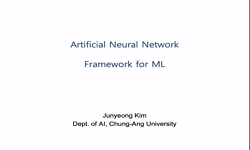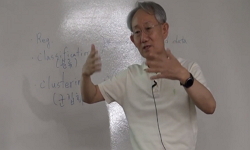This paper presents a systematic design and training procedure for the feed-forward backpropagation neural network (NN) modeling of both forward and inverse behavior of a rotary magnetorheological (MR) damper based on experimental data. For the forwar...
http://chineseinput.net/에서 pinyin(병음)방식으로 중국어를 변환할 수 있습니다.
변환된 중국어를 복사하여 사용하시면 됩니다.
- 中文 을 입력하시려면 zhongwen을 입력하시고 space를누르시면됩니다.
- 北京 을 입력하시려면 beijing을 입력하시고 space를 누르시면 됩니다.



Experimental calibration of forward and inverse neural networks for rotary type magnetorheological damper
한글로보기https://www.riss.kr/link?id=A104817209
-
저자
Subrata Bhowmik (Technical University of Denmark) ; Felix Weber (Swiss Federal Laboratories for Materials Science and Technology) ; Jan Høgsberg (Technical University of Denmark)
- 발행기관
- 학술지명
- 권호사항
-
발행연도
2013
-
작성언어
-
- 주제어
-
등재정보
KCI등재,SCIE,SCOPUS
-
자료형태
학술저널
-
수록면
673-693(21쪽)
-
KCI 피인용횟수
10
- 제공처
-
0
상세조회 -
0
다운로드
부가정보
다국어 초록 (Multilingual Abstract)
This paper presents a systematic design and training procedure for the feed-forward backpropagation neural network (NN) modeling of both forward and inverse behavior of a rotary magnetorheological (MR) damper based on experimental data. For the forward damper model, with damper force as output, an optimization procedure demonstrates accurate training of the NN architecture with only current and velocity as input states. For the inverse damper model, with current as output, the absolute value of velocity and force are used as input states to avoid negative current spikes when tracking a desired damper force. The forward and inverse damper models are trained and validated experimentally, combining a limited number of harmonic displacement records, and constant and half-sinusoidal current records. In general the validation shows accurate results for both forward and inverse damper models, where the observed modeling errors for the inverse model can be related to knocking effects in the measured force due to the bearing plays between hydraulic piston and MR damper rod. Finally, the validated models are used to emulate pure viscous damping. Comparison of numerical and experimental results demonstrates good agreement in the post-yield region of the MR damper, while the main error of the inverse NN occurs in the pre-yield region where the inverse NN overestimates the current to track the desired viscous force.
참고문헌 (Reference)
1 Aguirre, N., "Viscous and Dahl model for MR dampers characterization: A Real time hybrid test (RTHT) validation" 2010
2 Neelakantan, V.A., "Vibration control of structural systems using MR dampers and a ‘modified’ sliding mode control technique" 19 (19): 211-224, 2008
3 Li, H., "Vibration control of stay cables of the Shandong Binzhou yellow river highway bridge using magnetorheological fluid dampers" 12 (12): 401-409, 2007
4 Metered, H., "The experimental identification of magnetorheological dampers and evaluation of their controllers" 24 (24): 976-994, 2009
5 Soeiro, F. J., "Stochastic and hybrid methods for the identification in the Bouc-Wen model for magneto-rheological dampers" 135 : 012093-, 2008
6 Spencer, Jr. B.F., "State of the art of structural control" 129 (129): 845-856, 2003
7 Tse, T., "Shear-mode rotary magnetorheological damper for small-scale structural control experiments" 130 (130): 904-910, 2004
8 Weber, F., "Passive damping of cables with MR dampers" 38 (38): 568-577, 2005
9 Ye, M., "Parameter estimation of the Bouc-Wen hysteresis model using particle swarm optimization" 16 (16): 2341-2349, 2007
10 Xiaomin, X., "Parameter estimation and its sensitivity analysis of the MR damper hysteresis model using a modified genetic algorithm" 20 (20): 2089-2100, 2009
1 Aguirre, N., "Viscous and Dahl model for MR dampers characterization: A Real time hybrid test (RTHT) validation" 2010
2 Neelakantan, V.A., "Vibration control of structural systems using MR dampers and a ‘modified’ sliding mode control technique" 19 (19): 211-224, 2008
3 Li, H., "Vibration control of stay cables of the Shandong Binzhou yellow river highway bridge using magnetorheological fluid dampers" 12 (12): 401-409, 2007
4 Metered, H., "The experimental identification of magnetorheological dampers and evaluation of their controllers" 24 (24): 976-994, 2009
5 Soeiro, F. J., "Stochastic and hybrid methods for the identification in the Bouc-Wen model for magneto-rheological dampers" 135 : 012093-, 2008
6 Spencer, Jr. B.F., "State of the art of structural control" 129 (129): 845-856, 2003
7 Tse, T., "Shear-mode rotary magnetorheological damper for small-scale structural control experiments" 130 (130): 904-910, 2004
8 Weber, F., "Passive damping of cables with MR dampers" 38 (38): 568-577, 2005
9 Ye, M., "Parameter estimation of the Bouc-Wen hysteresis model using particle swarm optimization" 16 (16): 2341-2349, 2007
10 Xiaomin, X., "Parameter estimation and its sensitivity analysis of the MR damper hysteresis model using a modified genetic algorithm" 20 (20): 2089-2100, 2009
11 Chang, C., "Neural network modeling of a magnetorheological damper" 9 (9): 755-764, 1998
12 Chang, C., "Neural network emulation of inverse dynamics for a magnetorheological damper" 128 (128): 231-239, 2002
13 Dominguez, A., "Modelling the hysteresis phenomenon of magnetorheological dampers" 13 (13): 1351-1361, 2004
14 Boston, C., "Modeling of a disk-type magnetorheological damper" 19 (19): 045005-, 2010
15 Ikhouane, F., "Modeling and identification of a shear mode magnetorheological damper" 16 (16): 605-616, 2007
16 Wang, D.H., "Modeling and control of magnetorheological fluid dampers using neural networks" 14 (14): 111-126, 2005
17 Weber, F., "Measured tracking of negative stiffness with MR damper" 2011
18 Jiménez, R., "LuGre friction model for a magnetorheological damper" 12 (12): 91-116, 2005
19 Won, J.-S., "Fuzzy modelling approach to magnetorheological dampers: forward and inverse model" 223 (223): 1055-1066, 2009
20 Tsoukalas, L., "Fuzzy and Neural Approaches in Engineering" John Wiley & Sons Inc 1997
21 Weber, F., "Frequency and damping adaptation of a TMD with controlled MR damper" 21 (21): 055011-, 2012
22 Weber, F., "Extended Neural Network Based Scheme for Real-Time Force Tracking with MR Dampers" 2013
23 Christenson, R. E., "Experimental verification of smart cable damping" 132 (132): 268-278, 2006
24 Maslanka, M., "Experimental study of vibration control of a cable with an attached MR damper" 45 (45): 893-917, 2007
25 Shulman, Z. P., "Energy dissipation in electrorheological damping devices" 17 (17): 315-320, 2006
26 Yang, G., "Dynamic modeling of large-scale magneto-rheological damper systems for civil engineering applications" 130 (130): 1107-1114, 2004
27 Yang, F., "Development of LuGre friction model for large-scale magneto-rheological fluid damper" 20 (20): 923-937, 2009
28 F. Weber, "Detailed analysis and modelling of MR dampers at zero current" 국제구조공학회 30 (30): 787-790, 2008
29 Weber, F., "Cycle energy control of MR dampers on cables" 18 (18): 015005-, 2009
30 Sahin, I., "Comparison of some existing parametric models for magnetorheological fluid dampers" 19 (19): 035012-, 2010
31 Weber, F., "Clipped viscous damping with negative stiffness for semi-active cable damping" 20 (20): 045007-, 2011
32 W.J. Wu, "Cable vibration control with a semiactive MR damper-numerical simulation and experimental verification" 국제구조공학회 34 (34): 611-623, 2010
33 Weber, F., "Bouc-Wen model-based real-time force tracking scheme for MR dampers" 22 (22): 045012-, 2013
34 Xia, P., "An inverse model of MR damper using optimal neural network and system identification" 266 (266): 1009-1023, 2003
35 Lee, H., "An experimental study of semiactive modal neuro-control scheme using MR damper for building structure" 19 (19): 1005-1015, 2008
36 Weber, F., "An adaptive tuned mass damper based on the emulation of positive and negative stiffness with an MR damper" 20 (20): 015012-, 2011
37 Sims, N. D., "A unified modelling and model updating procedure for electrorheological and magnetorheological vibration dampers" 13 (13): 100-121, 2004
38 Dominguez, A., "A new dynamic hysteresis model for magnetorheological dampers" 15 (15): 1179-1189, 2006
동일학술지(권/호) 다른 논문
-
Investigating the effect of bond slip on the seismic response of RC structures
- 국제구조공학회
- Mohammad Mehdi Fallah
- 2013
- KCI등재,SCIE,SCOPUS
-
- 국제구조공학회
- Gang Li
- 2013
- KCI등재,SCIE,SCOPUS
-
Condition assessment of raking damaged bulk carriers under vertical bending moments
- 국제구조공학회
- 김도균
- 2013
- KCI등재,SCIE,SCOPUS
-
Development of non-destructive method of detecting steel bars corrosion in bridge decks
- 국제구조공학회
- Javad Sadeghi
- 2013
- KCI등재,SCIE,SCOPUS
분석정보
인용정보 인용지수 설명보기
학술지 이력
| 연월일 | 이력구분 | 이력상세 | 등재구분 |
|---|---|---|---|
| 2022 | 평가예정 | 해외DB학술지평가 신청대상 (해외등재 학술지 평가) | |
| 2021-12-01 | 평가 | 등재후보 탈락 (해외등재 학술지 평가) | |
| 2020-12-01 | 평가 | 등재후보로 하락 (해외등재 학술지 평가) |  |
| 2011-01-01 | 평가 | 등재학술지 유지 (등재유지) |  |
| 2009-01-01 | 평가 | 등재학술지 유지 (등재유지) |  |
| 2007-04-09 | 학회명변경 | 한글명 : (사)국제구조공학회 -> 국제구조공학회 |  |
| 2007-01-01 | 평가 | 등재학술지 유지 (등재유지) |  |
| 2005-06-16 | 학회명변경 | 영문명 : Ternational Association Of Structural Engineering And Mechanics -> International Association of Structural Engineering And Mechanics |  |
| 2005-05-26 | 학술지명변경 | 한글명 : 국제구조계산역학지 -> Structural Engineering and Mechanics, An Int'l Journal |  |
| 2005-01-01 | 평가 | 등재학술지 유지 (등재유지) |  |
| 2002-01-01 | 평가 | 등재학술지 선정 (등재후보2차) |  |
| 1999-01-01 | 평가 | 등재후보학술지 선정 (신규평가) |  |
학술지 인용정보
| 기준연도 | WOS-KCI 통합IF(2년) | KCIF(2년) | KCIF(3년) |
|---|---|---|---|
| 2016 | 1.12 | 0.62 | 0.94 |
| KCIF(4년) | KCIF(5년) | 중심성지수(3년) | 즉시성지수 |
| 0.79 | 0.68 | 0.453 | 0.33 |




 KCI
KCI






